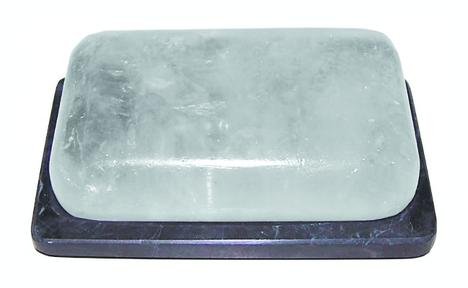
Q: Is the alum in crystal deodorants really safer than the aluminum in antiperspirants?
A: Whoever first marketed the crystal to the West was brilliant. What granola-eating earth-lovers wouldn’t want to stick it to Procter & Gamble by rubbing a crystal, of all things, under their arms?
These wet-‘n’-rub rocks seem a little suspicious, however. Isn’t the potassium alum in them just an aluminum salt? Well, yes. But it behaves differently, argue its proponents, who maintain it’s not absorbed by the body because of the size and negative ionic charge of the particles. To be honest, there’s no hard clinical research investigating the matter, so it’s anyone’s guess. (Any chem students up for a little experimentation?)
What I can tell you is that plenty of people ingest potassium alum (aka potash alum or aluminum potassium sulfate) quite intentionally. It’s used in pickling to add crunch, and in some natural aftershaves to help heal little nicks.
It’s sold as an Ayurvedic tooth powder, and traditional Chinese and Ayurvedic medicine use potassium alum as an antiseptic for wounds, tonsillitis and acne, as well as a skin tightener. The World Health Organization advises people in developing countries to add a pinch to water storage vessels to prevent fecal coliform contamination. It’s also used as an adjuvant/immune booster in vaccines. (What, you don’t find the vaccine thing comforting?)
Of course, common usage doesn’t put a compound in the clear. Just peek at a tin can lining to see an official toxin, bisphenol A, in action. The key here is that there are no studies linking potassium alum to neurotoxicity, while there are for other forms of aluminum.
Aluminum remains controversial in alternative health circles partly because it’s been found at greater levels in the brains of Alzheimer’s patients. To be clear, there’s no conclusive evidence linking aluminum to Alzheimer’s, and the U.S. Food and Drug Administration considers the link “not resolved.”
Still, the FDA acknowledges that “a small amount” of aluminum can be absorbed through the skin and that those with kidney problems may have trouble excreting it. In 2004, the FDA directed makers of all aluminum-laced antiperspirants to warn people with kidney disease to consult a physician before using them.
Assuming the alum in a crystal isn’t absorbed by the body and you’re in the clear health-wise, how does health-store deo fare on the eco scale?
Well, potassium alum occurs in one of two ways: as a naturally occurring mineral (called alunite or kalunite), or synthesized from leached alumina from mined bauxite, by means of some fancy chemistry. If it’s got the visible imperfections of a quartz crystal, it’s likely naturally sourced if it’s more consistently opaque, it could be synthetic. Either way, mining’s involved, which means it certainly isn’t impact-free, but the synthetic process is more energy-intensive.
Synthetic or not, your crystal has a lower impact than the stew of nefarious ingredients in drugstore sticks. Those are often full of environmentally toxic and bioaccumulative cyclopentasiloxane or cyclomethicone, destructively mined talc, endocrine-disrupting triclosan, hormone-disruptor-laced synthetic scents and an armpitful of petrochemicals. I don’t care how dry it makes me, I ain’t raising my hand to vouch for that.
Got a question?
Send your green queries to ecoholic@nowtoronto.com












